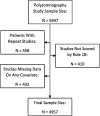Sleep time and efficiency in patients undergoing laboratory-based polysomnography
- PMID: 33739259
- PMCID: PMC8656908
- DOI: 10.5664/jcsm.9252
Sleep time and efficiency in patients undergoing laboratory-based polysomnography
Abstract
Study objectives: Sleep quality in patients studied with laboratory-based polysomnography may differ from sleep quality in patients studied at home but remains clinically relevant and important to describe. We assessed objective sleep quality and explored factors associated with poor sleep in patients undergoing laboratory-based polysomnography.
Methods: We reviewed diagnostic polysomnography studies from a 10-year period at a single sleep center. Total sleep time (TST) and sleep efficiency (SE) were assessed as markers of sleep quality. Poor sleep was defined as TST ≤ 4 hours or SE ≤ 50%. Multivariable analysis was performed to determine associations between objective sleep quality as an outcome and multiple candidate predictors including age, sex, race, body mass index, comorbidities, severity of obstructive sleep apnea, and central nervous system medications.
Results: Among 4957 patients (age 53 ± 15 years), average TST and median SE were 5.8 hours and 79%, respectively. There were 556 (11%) and 406 (8%) patients who had poor sleep based on TST and SE, respectively. In multivariable analysis, those who were older (per 10 years: 1.48 [1.34, 1.63]), male (1.38 [1.14,1.68]), and had severe obstructive sleep apnea (1.76 [1.28, 2.43]) were more likely to have short sleep. Antidepressant use was associated with lower odds of short sleep (0.77 [0.59,1.00]). Older age (per 10 years: 1.48 [1.34, 1.62]), male sex (1.34 [1.07,1.68]), and severe obstructive sleep apnea (2.16 [1.47, 3.21]) were associated with higher odds of poor SE.
Conclusions: We describe TST and SE from a single sleep center cohort. Multiple demographic characteristics were associated with poor objective sleep in patients during laboratory-based polysomnography.
Citation: Harrison EI, Roth RH, Lobo JM, et al. Sleep time and efficiency in patients undergoing laboratory-based polysomnography. J Clin Sleep Med. 2021;17(8):1591-1598.
Keywords: polysomnography; sleep; sleep quality.
© 2021 American Academy of Sleep Medicine.
Figures
Similar articles
-
Overnight polysomnography versus respiratory polygraphy in the diagnosis of pediatric obstructive sleep apnea.Sleep. 2014 Feb 1;37(2):255-60. doi: 10.5665/sleep.3392. Sleep. 2014. PMID: 24497654 Free PMC article.
-
Depressive symptoms are associated with poor sleep quality rather than apnea-hypopnea index or hypoxia during sleep in patients with obstructive sleep apnea.Sleep Breath. 2017 Dec;21(4):997-1003. doi: 10.1007/s11325-017-1550-1. Epub 2017 Aug 19. Sleep Breath. 2017. PMID: 28825197
-
Gender differences in polysomnographic findings in Turkish patients with obstructive sleep apnea syndrome.Eur Arch Otorhinolaryngol. 2008 Jul;265(7):821-4. doi: 10.1007/s00405-007-0554-z. Epub 2007 Dec 8. Eur Arch Otorhinolaryngol. 2008. PMID: 18066571
-
Clinical Practice Guideline: Tonsillectomy in Children (Update)-Executive Summary.Otolaryngol Head Neck Surg. 2019 Feb;160(2):187-205. doi: 10.1177/0194599818807917. Otolaryngol Head Neck Surg. 2019. PMID: 30921525 Review.
-
Investigating the relationship between objective measures of sleep and self-report sleep quality in healthy adults: a review.J Clin Sleep Med. 2022 Mar 1;18(3):927-936. doi: 10.5664/jcsm.9708. J Clin Sleep Med. 2022. PMID: 34609276 Free PMC article. Review.
Cited by
-
Association between sleep quality and nocturnal erection monitor by RigiScan in erectile dysfunction patients: a prospective study using fitbit charge 2.Basic Clin Androl. 2023 Nov 27;33(1):31. doi: 10.1186/s12610-023-00206-x. Basic Clin Androl. 2023. PMID: 38008740 Free PMC article.
-
A Feasibility Study on Smart Mattresses to Improve Sleep Quality.J Healthc Eng. 2021 Aug 3;2021:6127894. doi: 10.1155/2021/6127894. eCollection 2021. J Healthc Eng. 2021. PMID: 34394894 Free PMC article.
-
Dyslipidemia prevalence in nonobese, nondiabetic patients with obstructive sleep apnea: does sex matter?J Clin Sleep Med. 2023 May 1;19(5):889-898. doi: 10.5664/jcsm.10490. J Clin Sleep Med. 2023. PMID: 36708260 Free PMC article.
-
Characteristics of Obstructive Sleep Apnea Patients With Hypertension and Factors Associated With Autotitration Acceptance.Front Psychiatry. 2022 Jan 4;12:706275. doi: 10.3389/fpsyt.2021.706275. eCollection 2021. Front Psychiatry. 2022. PMID: 35058810 Free PMC article.
-
Perceptions of the Use of Mobile Apps to Assess Sleep-Dependent Memory in Older Adults With Subjective and Objective Cognitive Impairment: Focus Group Approach.JMIR Aging. 2025 Apr 28;8:e68147. doi: 10.2196/68147. JMIR Aging. 2025. PMID: 40294432 Free PMC article.
References
-
- Schmidt HS , Kaelbling R . The differential laboratory adaptation of sleep parameters . Biol Psychiatry . 1971. ; 3 ( 1 ): 33 – 45 . - PubMed
-
- Edinger JD , Fins AI , Sullivan RJ Jr , et al. . Sleep in the laboratory and sleep at home: comparisons of older insomniacs and normal sleepers . Sleep . 1997. ; 20 ( 12 ): 1119 – 1126 . - PubMed
-
- Mendels J , Hawkins DR . Sleep laboratory adaptation in normal subjects and depressed patients (“first night effect”) . Electroencephalogr Clin Neurophysiol . 1967. ; 22 ( 6 ): 556 – 558 . - PubMed
-
- Hauri PJ , Olmstead EM . Reverse first night effect in insomnia . Sleep . 1989. ; 12 ( 2 ): 97 – 105 . - PubMed
Publication types
MeSH terms
Grants and funding
LinkOut - more resources
Full Text Sources
Other Literature Sources
Medical



